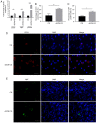Human cardiac extracellular matrix-chitosan-gelatin composite scaffold and its endothelialization
- PMID: 32010293
- PMCID: PMC6966153
- DOI: 10.3892/etm.2019.8349
Human cardiac extracellular matrix-chitosan-gelatin composite scaffold and its endothelialization
Abstract
The present study developed a cardiac extracellular matrix-chitosan-gelatin (cECM-CG) composite scaffold that can be used as a tissue-engineered heart patch and investigated its endothelialization potential by incorporating CD34+ endothelial progenitor cells (EPCs). The cECM-CG composite scaffold was prepared by blending cardiac extracellular matrix (cECM) with biodegradable chitosan-gelatin (CG). The mixture was lyophilized using vacuum freeze-drying. CD34+ EPCs were isolated and seeded on the scaffolds, and then the endothelialization effect was subsequently investigated. Effects of the scaffolds on CD34+ EPCs survival and proliferation were evaluated by immunofluorescence staining and MTT assay. Cell differentiation into endothelial cells and the influence of the scaffolds on cell differentiation were investigated by reverse transcription-quantitative PCR (RT-qPCR), immunofluorescence staining and tube formation assay. The present results indicated that most cells were removed after decellularization, but the main extracellular matrix components were retained. Scanning electron microscopy imaging illustrated three-dimensional and porous scaffolds. The present results suggested the cECM-CG composite scaffold had a higher water absorption ability compared with the CG scaffold. Additionally, compared with the CG scaffold, the cECM-CG composite scaffold significantly increased cell survival and proliferation, which suggested its non-toxicity and biocompatibility. Furthermore, RT-qPCR, immunofluorescence and tube formation assay results indicated that CD34+ EPCs differentiated into endothelial cells, and the cECM-CG composite scaffold promoted this differentiation process. In conclusion, the present results indicated that the human cECM-CG composite scaffold generated in the present study was a highly porous, biodegradable three-dimensional scaffold which supported endothelialization of seeded CD34+ EPCs. The present results suggested that this cECM-CG composite scaffold may be a promising heart patch for use in heart tissue engineering for congenital heart disease.
Keywords: cardiac extracellular matrix; endothelial progenitor cells; endothelialization; heart patch; scaffold.
Copyright: © Lv et al.
Figures




Similar articles
-
Cardiac Extracellular Matrix Scaffold Generated Using Sarcomeric Disassembly and Antigen Removal.Ann Biomed Eng. 2016 Apr;44(4):1047-60. doi: 10.1007/s10439-015-1404-6. Epub 2015 Jul 28. Ann Biomed Eng. 2016. PMID: 26215309
-
Skeletal Extracellular Matrix Supports Cardiac Differentiation of Embryonic Stem Cells: a Potential Scaffold for Engineered Cardiac Tissue.Cell Physiol Biochem. 2018;45(1):319-331. doi: 10.1159/000486813. Epub 2018 Jan 19. Cell Physiol Biochem. 2018. PMID: 29402858
-
A Bioprinted Cardiac Patch Composed of Cardiac-Specific Extracellular Matrix and Progenitor Cells for Heart Repair.Adv Healthc Mater. 2018 Dec;7(23):e1800672. doi: 10.1002/adhm.201800672. Epub 2018 Oct 31. Adv Healthc Mater. 2018. PMID: 30379414 Free PMC article.
-
Applications of Cardiac Extracellular Matrix in Tissue Engineering and Regenerative Medicine.Adv Exp Med Biol. 2018;1098:59-83. doi: 10.1007/978-3-319-97421-7_4. Adv Exp Med Biol. 2018. PMID: 30238366 Review.
-
[Development of cartilage extracellular matrix in cartilage tissue engineering].Hua Xi Kou Qiang Yi Xue Za Zhi. 2019 Apr 1;37(2):220-223. doi: 10.7518/hxkq.2019.02.016. Hua Xi Kou Qiang Yi Xue Za Zhi. 2019. PMID: 31168991 Free PMC article. Review. Chinese.
Cited by
-
Chitosan-Based Composites: Development and Perspective in Food Preservation and Biomedical Applications.Polymers (Basel). 2023 Jul 25;15(15):3150. doi: 10.3390/polym15153150. Polymers (Basel). 2023. PMID: 37571044 Free PMC article. Review.
-
Chitosan: A Potential Biopolymer in Drug Delivery and Biomedical Applications.Pharmaceutics. 2023 Apr 21;15(4):1313. doi: 10.3390/pharmaceutics15041313. Pharmaceutics. 2023. PMID: 37111795 Free PMC article. Review.
-
A Review on the Applications of Natural Biodegradable Nano Polymers in Cardiac Tissue Engineering.Nanomaterials (Basel). 2023 Apr 15;13(8):1374. doi: 10.3390/nano13081374. Nanomaterials (Basel). 2023. PMID: 37110959 Free PMC article. Review.
-
Application of biomedical materials in the diagnosis and treatment of myocardial infarction.J Nanobiotechnology. 2023 Aug 26;21(1):298. doi: 10.1186/s12951-023-02063-2. J Nanobiotechnology. 2023. PMID: 37626396 Free PMC article. Review.
-
Angiogenesis and Re-endothelialization in decellularized scaffolds: Recent advances and current challenges in tissue engineering.Front Bioeng Biotechnol. 2023 Feb 16;11:1103727. doi: 10.3389/fbioe.2023.1103727. eCollection 2023. Front Bioeng Biotechnol. 2023. PMID: 36873356 Free PMC article. Review.
References
-
- Benjamin EJ, Muntner P, Alonso A, Bittencourt MS, Callaway CW, Carson AP, Chamberlain AM, Chang AR, Cheng S, Das SR, et al. Heart disease and stroke statistics-2019 update: A report from the American heart association. Circulation. 2019;139:e56–e528. doi: 10.1161/CIR.0000000000000659. - DOI - PubMed
-
- Kochupura PV, Azeloglu EU, Kelly DJ, Doronin SV, Badylak SF, Krukenkamp IB, Cohen IS, Gaudette GR. Tissue-engineered myocardial patch derived from extracellular matrix provides regional mechanical function. Circulation. 2005;112(Suppl 9):I144–I149. - PubMed
LinkOut - more resources
Full Text Sources
Other Literature Sources
